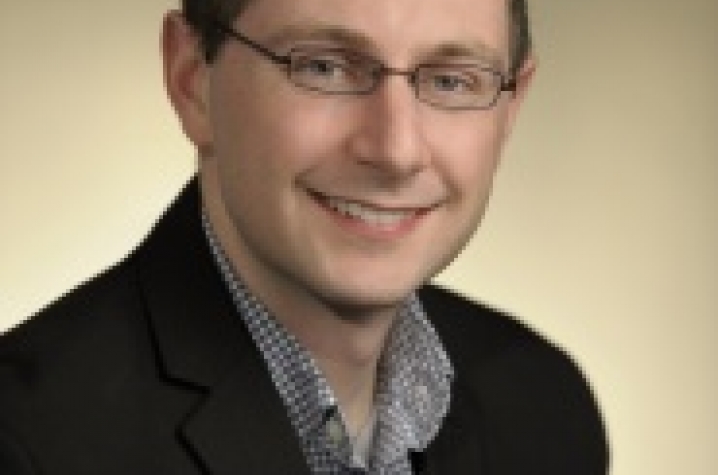UK Study Will Explore Novel MRI Techniques Safe for Patients with Kidney Failure

Lexington, Ky. (Aug. 11, 2015) — Moriel Vandsburger, PhD, assistant professor of physiology in the University of Kentucky College of Medicine, was awarded a five-year, $1.9 million R01 grant from the National Heart, Lung, and Blood Institute to study new MRI techniques that don't use contrast agents and are safe for patients with kidney failure. These patients experience increased risk for heart failure, but the chemical contrast agent used in current MRI technology is unsafe for them due to their compromised kidney function.
Dr. Steve Leung, associate director of advanced cardiovascular imaging, and Dr. Hartmut Malluche, chief of the division of nephrology, bone and mineral metabolism, also serve as co-investigators on the grant.
"This opens a new window of opportunity to understand heart failure in the setting of patients with kidney disease," Vandsburger said.
For the past two years Vandsburger has been working to develop MRI techniques that can identify scar tissue in the heart without using a chemical contrast agent. He initially developed the technique in mouse models during his postdoctoral fellowship at the Weizmann Institute of Science in Israel. Since joining the UK faculty in 2013, he has translated the findings into the human clinical setting with the support of the KL2 Career Development program from the Center for Clinical and Translational Science.
"In an earlier study that we finished last year, we compared our technique to the method that uses the contrast agent and we found very close agreement between our method and the standard method," Vandsburger said.
The R01 project will focus on validating the new method against the current standard of care. Vandsburger and his team will use MRI to explore and compare the morphologies of scar tissue in the hearts of two populations: patients who have had a heart attack and therefore have dense scar tissue in the heart, and patients with diabetes who are more likely to have diffuse scar tissue not caused by an acute cardiac event.
Previous research indicates that patients with kidney failure develop scar tissue in their hearts, but there has been no way to track changes in the scar tissue--and monitor risk of heart failure--because they can't be screened using standard MRIs which require a chemical contrast agent.
"The real crux will be applying this technique to study patients with renal failure," Vandsburger said. "The renal failure field has advanced so much that people on hemodialysis might not die from kidney disease, but an overwhelming number die of cardiac causes. So there's a growing recognition that we need to understand what causes heart failure in these patients. And hopefully we can look at these patients with kidney failure to see if the scar tissue is the product of hemodialysis."
The research could also potentially identify an easily measurable blood biomarker to monitor scar tissue at the point of care, without biopsy or scans, as well as a signaling pathway that could be pharmaceutically targeted to reduce death from cardiac causes.
This is Vandsburger's first R01 award. He was 32 when it was awarded (he's since turned 33), a full decade younger than the average age of first-time R01-funded investigators who have PhDs. Also remarkable is that the grant was funded on the first submission. Vandsburger points to the support of the KL2 program and UK's culture of interdisciplinary collaboration, from clinicians to basic scientists at the Center for Muscle Biology, as factors in his successful application.
"I think that's really in large part due to the constant mentorship and environment established through the K Program," he said. "It helped me get the preliminary data that I needed for this grant. I submitted nine grant proposals in the first year and a half at UK, and most of them were on this or similar subjects. I workshopped every single grant and aims page at K Club, and it was really the constant feedback of people that overtime helped me improve the quality of grant writing, improve the focus, improve the outcomes."
Collaborating with clinicians has been equally critical to the research. By working directly with Leung, Vandsburger was able to engage with and recruit patients to participate in the study. Dr. Susan Smyth, chief of the Division of Cardiovascular Medicine, served as Vandsburger's primary mentor in the KL2 Program, providing expert feedback from the perspective of a seasoned physician scientist. Vandsburger will also collaborate with Malluche to help recruit patients and understand the findings in the heart's scar tissue with respect to kidney function.
"I really benefit from that kind of culture of inclusiveness—where people at the Gill Heart Institute really want people to succeed—and I think that's part of why I got the grant funded so quickly," Vandsburger said.
While relatively young for an R01 awardee, he traces his research interests back to a childhood love for Legos and photography.
"If you put Legos and photography together, you get MRI," Vandsburger said. "Where I grew up there was nothing to do. So I got a Pentax camera and went around shooting black and white photography."
Similarly, his current work combines disciplines and tools.
"My research brings together some of the most exciting parts of science - the physics behind MRI, the engineering of designing new methods and tools for analysis, and the biology of heart failure. It lets me have access to the best of every world," he said.
MEDIA CONTACT: Mallory Powell, Mallory.powell@uky.edu




